Build 2023: Qualcomm Pushes a Hybrid AI Approach
- Paul Thurrott
- May 23, 2023
-
1

Qualcomm was the first of Microsoft’s silicon partners to integrate AI capabilities into its chipsets, and now users will realize the benefits: PCs based on the Snapdragon 8cx Gen3 Compute Platform—like the thin and light Lenovo ThinkPad X13s I reviewed—can process local AI tasks at speeds dramatically faster than more traditional PCs with no neural processing unit (NPU).
“For generative AI to become truly mainstream, much of the inferencing will need to be executed on edge devices,” Qualcomm senior vice president Ziad Asghar says. “Our best-in-class AI hardware and software empowers developers to make full use of our powerful AI capabilities, delivering incredible new user experiences on laptops, phones, and other devices powered by Snapdragon.”
Windows Intelligence In Your Inbox
Sign up for our new free newsletter to get three time-saving tips each Friday — and get free copies of Paul Thurrott's Windows 11 and Windows 10 Field Guides (normally $9.99) as a special welcome gift!
"*" indicates required fields
Qualcomm’s vision is that the future of AI is best realized with AI on both the client and in the cloud because it improves cost-effectiveness, privacy, personalization, and latency. And Qualcomm has worked across 7 generations of chipsets to bring its so-called AI Engine—a combination of CPU, GPU, and NPU—to market, first with smartphones and now on the PC as well. So it’s nicely positioned for the move to AI workloads that Microsoft is showing off at Build.
Qualcomm provided with me a series of ThinkPad X13s-based demos ahead of the conference to make its point: Stable Diffusion, a text-to-image generative AI model with over one billion parameters, can now run locally on this and other Snapdragon-based PCs. And the performance is astonishing, with up to nine times the performance when compared to typical CPU/GPU-based PCs. To see anywhere near this kind of speed on a non-Snapdragon PC, you would need a tower PC with an expensive and beefy GPU.
To help developers target its AI Engine, Qualcomm is also releasing its internal SDK to the public for the first time. “With the ONNX Runtime and Qualcomm AI Stack, you can run your AI workloads today on the Snapdragon 8cx Gen 3 AI Engine on both the Surface Pro 9 5G and Lenovo ThinkPad x13s,” Qualcomm notes. The firm is also opening a new Windows on Snapdragon developer portal on the web.